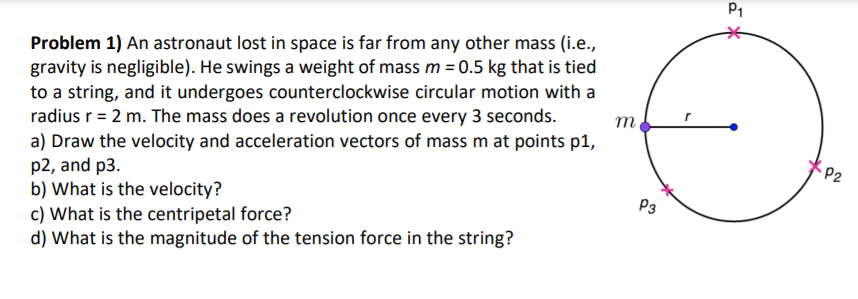An astronaut lost in space is far from any other mass (i.e., gravity is negligible). He swings a weight of mass m = 0.5 kg that is tied to a string, and it undergoes counterclockwise circular motion with a radius r = 2 m. The mass does a revolution once every 3 seconds. a) Draw the velocity and acceleration vectors of mass m at points p1, p2, and p3. b) What is the velocity? c) What is the centripetal force? d) What is the magnitude of the tension force in the string?
An astronaut lost in space is far from any other mass (i.e., gravity is negligible). He swings a weight of mass m = 0.5 kg that is tied to a string, and it undergoes counterclockwise circular motion with a radius r = 2 m. The mass does a revolution once every 3 seconds. a) Draw the velocity and acceleration vectors of mass m at points p1, p2, and p3. b) What is the velocity? c) What is the centripetal force? d) What is the magnitude of the tension force in the string?
Principles of Physics: A Calculus-Based Text
5th Edition
ISBN:9781133104261
Author:Raymond A. Serway, John W. Jewett
Publisher:Raymond A. Serway, John W. Jewett
Chapter3: Motion In Two Dimensions
Section: Chapter Questions
Problem 25P: As their booster rockets separate, Space Shuttle astronauts typically feel accelerations up to 3g,...
Related questions
Topic Video
Question
An astronaut lost in space is far from any other mass (i.e.,
gravity is negligible). He swings a weight of mass m = 0.5 kg that is tied
to a string, and it undergoes counterclockwise circular motion with a
radius r = 2 m. The mass does a revolution once every 3 seconds.
a) Draw the velocity and acceleration vectors of mass m at points p1,
p2, and p3.
b) What is the velocity?
c) What is the
d) What is the magnitude of the tension force in the string?

Transcribed Image Text:P1
Problem 1) An astronaut lost in space is far from any other mass (i.e.,
gravity is negligible). He swings a weight of mass m = 0.5 kg that is tied
to a string, and it undergoes counterclockwise circular motion with a
radius r= 2 m. The mass does a revolution once every 3 seconds.
a) Draw the velocity and acceleration vectors of mass m at points p1,
p2, and p3.
b) What is the velocity?
c) What is the centripetal force?
d) What is the magnitude of the tension force in the string?
m
P2
P3
Expert Solution
This question has been solved!
Explore an expertly crafted, step-by-step solution for a thorough understanding of key concepts.
This is a popular solution!
Trending now
This is a popular solution!
Step by step
Solved in 4 steps with 4 images

Knowledge Booster
Learn more about
Need a deep-dive on the concept behind this application? Look no further. Learn more about this topic, physics and related others by exploring similar questions and additional content below.Recommended textbooks for you

Principles of Physics: A Calculus-Based Text
Physics
ISBN:
9781133104261
Author:
Raymond A. Serway, John W. Jewett
Publisher:
Cengage Learning

Physics for Scientists and Engineers: Foundations…
Physics
ISBN:
9781133939146
Author:
Katz, Debora M.
Publisher:
Cengage Learning

Physics for Scientists and Engineers with Modern …
Physics
ISBN:
9781337553292
Author:
Raymond A. Serway, John W. Jewett
Publisher:
Cengage Learning

Principles of Physics: A Calculus-Based Text
Physics
ISBN:
9781133104261
Author:
Raymond A. Serway, John W. Jewett
Publisher:
Cengage Learning

Physics for Scientists and Engineers: Foundations…
Physics
ISBN:
9781133939146
Author:
Katz, Debora M.
Publisher:
Cengage Learning

Physics for Scientists and Engineers with Modern …
Physics
ISBN:
9781337553292
Author:
Raymond A. Serway, John W. Jewett
Publisher:
Cengage Learning

Physics for Scientists and Engineers
Physics
ISBN:
9781337553278
Author:
Raymond A. Serway, John W. Jewett
Publisher:
Cengage Learning